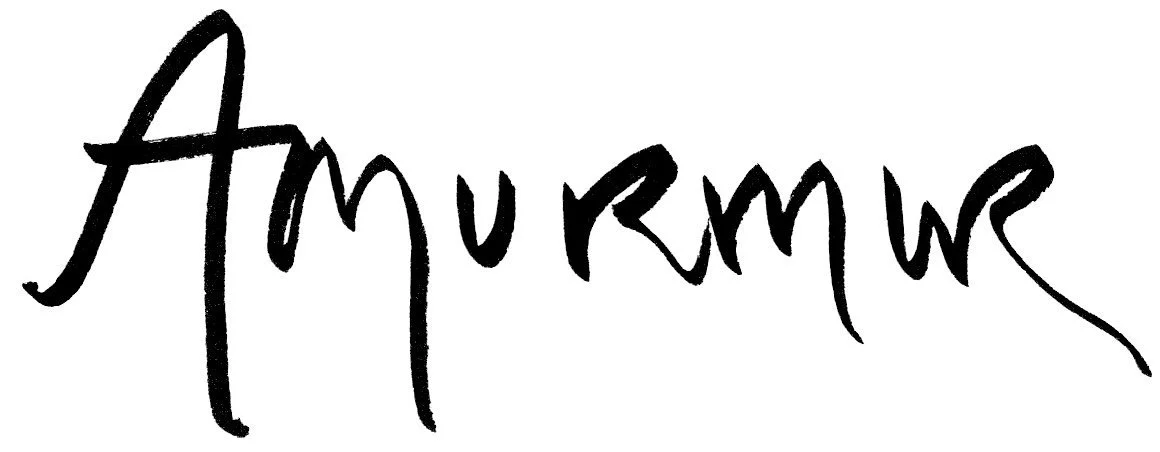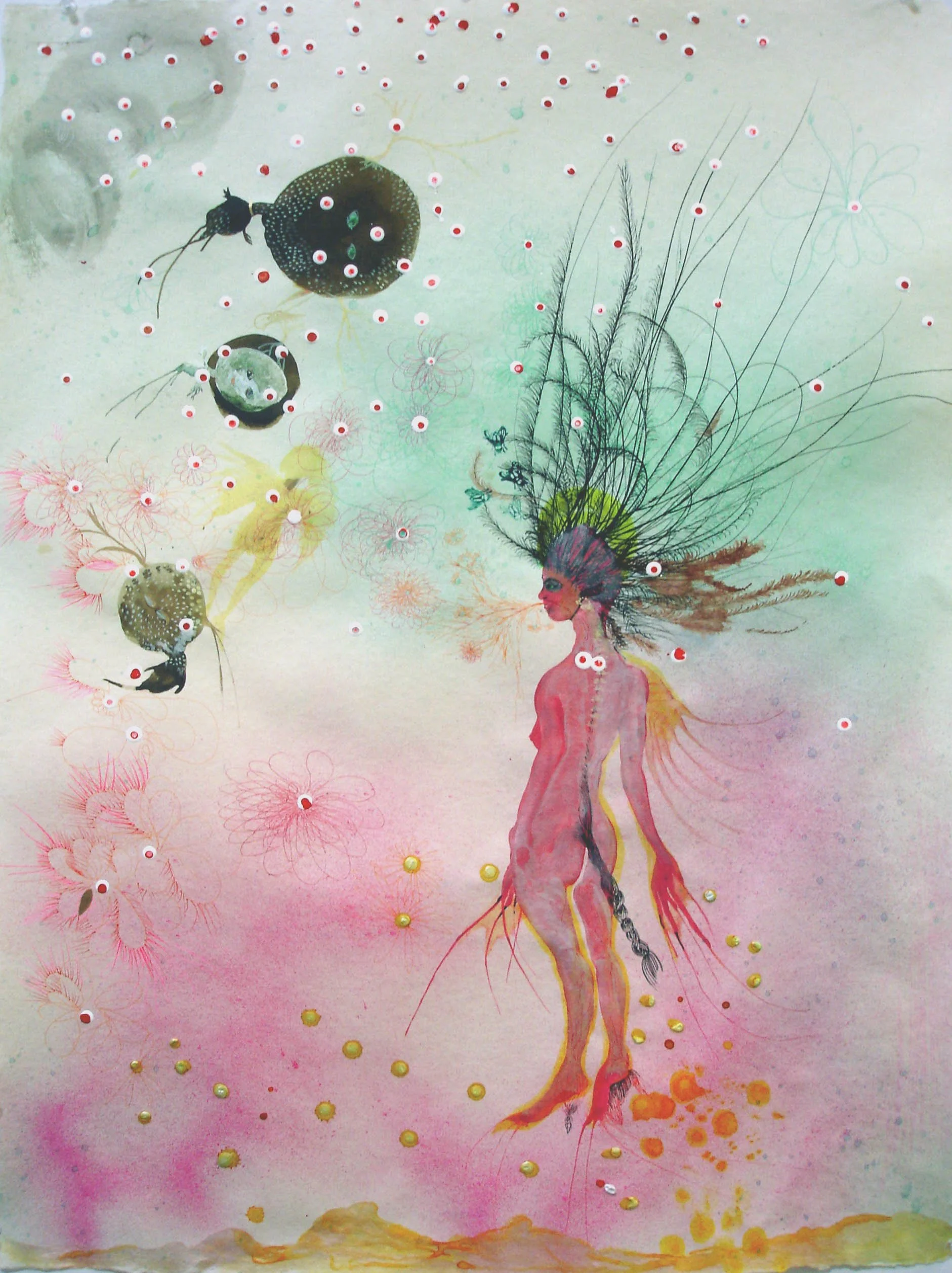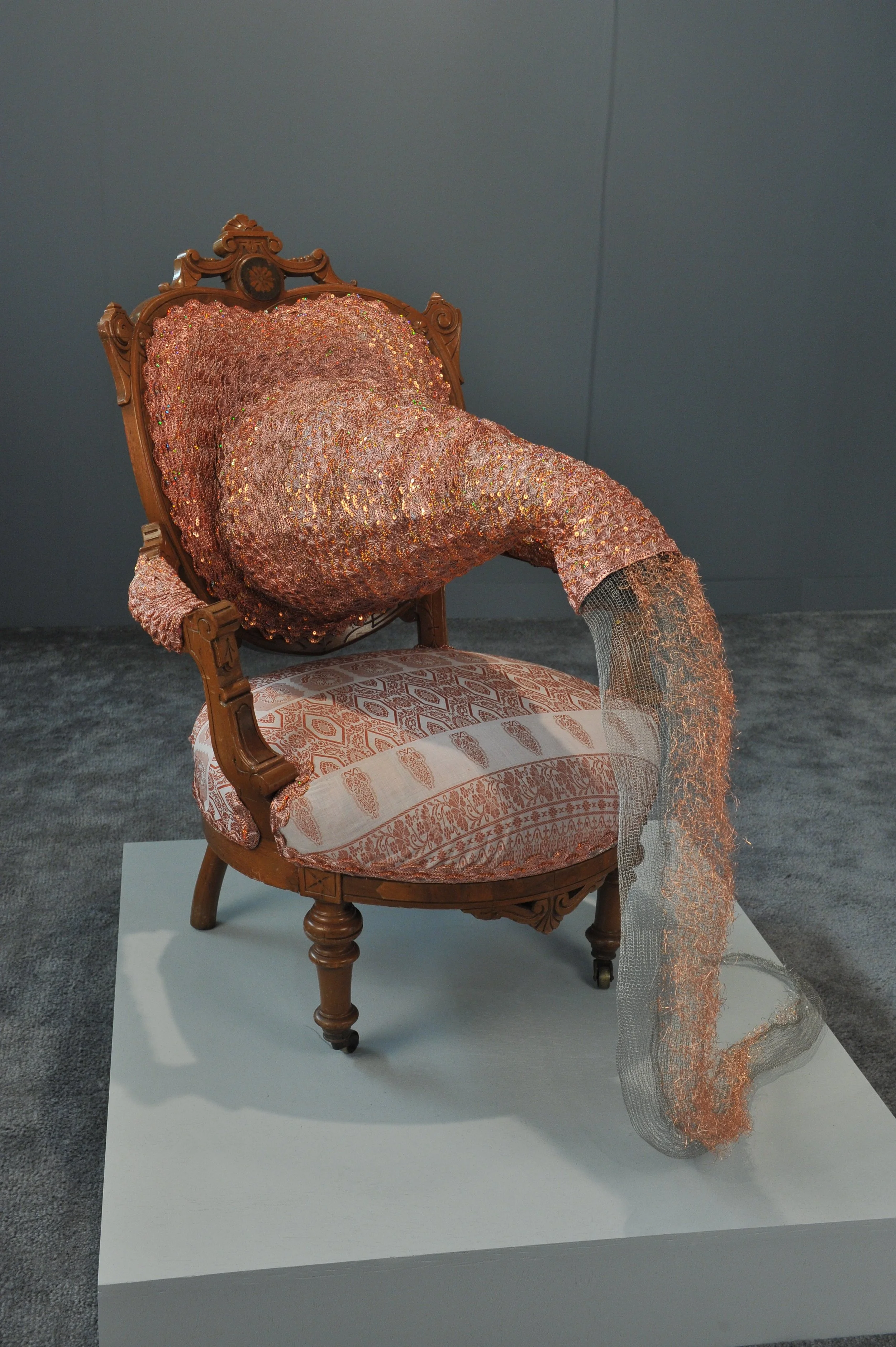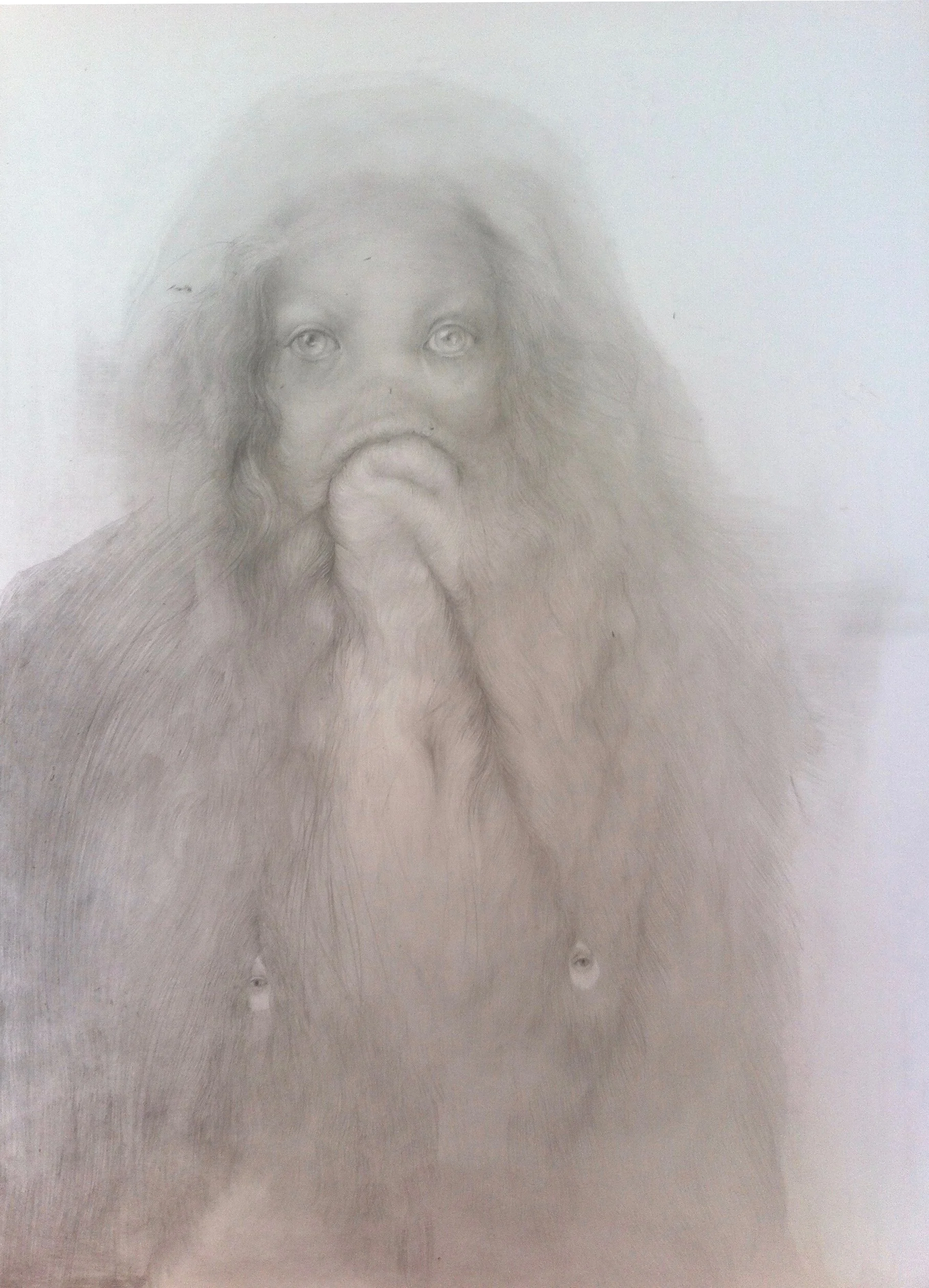Entre Deux Mondes: A Peculiar Other
The Land(s) of Anya Belyat-Giunta and Rina Banerjee, Respectively.
Of Land: the solid part of the surface of the earth. also: a corresponding part of a celestial body. Out land: A foreign land. Outlands plural: the outlying regions. All I can think of is Anya Belyat-Giunta. All I can see, Rina Banerjee. Planting these two florets together feels like wayward gardening, and extracting them from their magma an impossible weeding. Good dirt and holy water give strange fruit we shouldn’t gather, there’s no basket wild enough except the soil’s unbrushed hair. Lovely was this witch who drew her orange eggs (2013.) So we gently graze.
RINA BANERJEE In Full Bloom (2006)
Anya Belyat-Giunta named a piece 7th Continent (2015) but in her hands continents go by hundreds. Her titles evoke entering unmodified realities: Terra Incognita (2014,) The Crossing (2019,) The Other Side (2017,) Strange Spaces (2021.) “Displacement gave me wings,” she says, an artist no longer of one land but of air. The ultra finesse of her movement pulls in the “gentle strangeness” of what she has delivered and over an elongated period of observation, the tuber of her stories becomes unambiguous. Our conversations are lodgings for her dispersion because Anya is a child of displacement, of Inbetweenness (2011.) The environment of exile, one of deep silence, hushed her sound too as she became aware of lies that were “quite absurd behind the curtain” of the communist regime she grew under. Now in exile from a place she’s been told was once her home, “art was a means to exist that also became alienating.” The roads of exile may have silenced her decibels, but she pushed to uncover a shifted definition of the home. Of her land. “Home became the world I present in my work. A catalyst of time and space, where memory, presence and imagination converge.”
No holidays on a land of suffering but Belyat-Giunta’s uprooting has constructed vagabond imagination. Following a departure from Russia, she was schooled in Italy and the US and now resides in France. Between each of these identities are crevices, and Anya has lodged herself in them. Comfortably, restfully, agreeably? Certainly not. The bodies and shapes she found within these cracks have been understood in all their complexities and embraced as a whole. They are home to the artist who allows drifting, “learning to find home in people, loved ones, long friendships and in brief, luminous encounters. Home became less location in its physicality, more a presence. A way of being with places and others.” She stretches these caravan notions past, present and future through uncertain meandering: the dialog between optic and epiderm finally celebrated through stirs and sifting. Grooves and gurgles look incorrect but without a care in their world they deploy themselves, exhibiting their spontaneity without restraint. “Ils ont choisi l’incorrecte mais s’affichent, s’exhibent, spontanés, libres, instinctifs, sans contrôle et sans retenue.” (Julie Esteve)
ANYA BELYAT-GIUNTA Secret garden °1, (2023, private collection. photographed by Brice Leclert)
Make me a summary of the world, she was his guide and had travelled on camel, rhino, elephant and kangaroo, dedicated to dried plants, glass houses - for medical study, vegetable sexuality, self-pollination, fertilisation her reach pierced the woods country by country (2014)
Rina Banerjee, Queen of Cuddles (2009,) wrote “even as the continents grind against their faultlines and shake so will cultures as they meet. All that is silently, invisibly expanding in the universe will rise to have an effect and make things visible in all things smaller than itself.” When we speak she calls the movement of our head-to-head a “gift:” she in New York, not tidying her studio, and I, speaking in France, writing in the UK. “You and I so far away in the passage of time between my show at Pippy Houldsworth Gallery (London, 2023) where I don’t live. We connect and make intimacy,” In a Land Far Far Away (2017.) Banerjee creates connection within all that she anchors in her paintings as she sculpts her recognition of land as a piece of patchwork representing mobile identity. The motion within her bustling scenes show a readymade hideaway from the brutality and violence of those that have tried to conquer land. The artist shows no hesitation or regrets in displaying the original peacefulness of soil untamed. In her artwork, Banerjee speaks of beings “in float, flow, in air, above air, in water, with and without the land,” friends and foes without a static connection to a certain nature. Visible buoyancy and “some drowning in Earth too.” Unfixed, untamed ways of being feminine outside of our domesticated world call upon a “multiplicity of identities not based exclusively on a person’s culture of origin or gender, but instead on self identity and the spreading, fragmentation of cultures throughout the world,” (Jodi Thockmorton) Hybrid identity defies the gravity held within borders. Upon civilizing home an absurd and foreign fruit grew ripened, made food for the others, grew snout, tail and appendage like no other. (2010)
RINA BANERJEE Upon Civilizing Home… (2010)
Rina moved from India to the UK to the US and the cultural complexities of her upbringing have shaped the core of the suspended beings. “I identify the ‘intruder,’ ‘the body from another land’ and the ‘human contamination’ that ‘threaten’ peace.” Infectious Migrations (2000) and Human Traffic (2015) look at colonialist ideas of migrational infection and the gendered quality of disease, she depicts the “qualities of how we produce ‘other’ entrenched in how we think of disease and how we treat our neighbours.” [...] Making home for aliens not registered […] (2017,) her insatiable gathering of trinkets and fabrics refuses this notion of bacteria and germ but instead creates a visually inviting and tormenting assembly of cultural associations. ‘’Her gold-threaded fabrics, jeweled surfaces and Anglo-Indian antiques are steeped in the atrocities of colonialism. To be lured in by seductive colors and textures that seem to reverberate with temptation, only to be confronted with disorder and mutation, is to in some way experience the jarring duplicity at the core of this history.” (Jodi Thockmorton.) She was now in western style dress in part of Empires’ ruffle and red dress, had a foreign and peculiar race, a Ganesha who had lost her head, was thrown across sea until herself shipwrecked. A native of Bangladesh lost foot to root in videsh, followed her mother full stop on forehead, trapped tongue of horn and grew ram-like under stress (2014.) Rina Banerjee looks at uniformity in the eye and ushers it sideways wearing [...] a fantastic spray of pattern [...] (2008) whilst pollinating a world overflowing with independence. The mobility and groundlessness of her art amplifies any dissonance hiding in plain sight within the residue of network and history. Her captivity was once someone’s treasure and even pleasure but she blew and blew and then flew away took root which grew, we knew this was like no other feather, a third kind of bird that perched on vine intertwined was neither native nor her Queens daughter, a peculiar other. (2011)
RINA BANERJEE She Was Now In Western Style Dress… (2011)
ANYA BELYAT-GIUNTA The Other Side (2016, private collection)
Anya and Rina have both created spaces away from lords, masters and patriarchs who convicted ‘miscreants’ for their ‘otherness.’ Tentacled, tri-legged, tongues-out, guts spilled, clawing and bleeding, where else can these shes like The Poodle Girl (2017-2019) gyrate but in the bowels of new, undominated traditions of hidden yards? A Mad Woman, an Eternal Eve, a Monkey Cheated leaped, from limb to limp in open air [...] (2012)
“Elles n’existent pas ces bestioles, et pourtant elles sont là, qui vous suivent.” (Amélie Adamo) The critters of the agile pencil of Anya didn’t exist before her time but here they are now, following you as you close your eyes to what’s been sanitised and opening up a new kind of holy land. This undomesticated back yard spins a sanctified space on its head and offers a blessed ground for eroticism as we picture Baubo lifting her skirt and giggling. A cluster of “experiences inconfortables,” (Lorand Hegyi) salutes the discomfort of embracing peculiar skinquakes within explicit games of hide and seek. A land reserved for flaming impulses, undulations and misbehaving. With Hypertrichosis (2014,) a mutant has become the good kind of stroller. We wonder about the vital liquids hiding under her fur coat in Manteau de Fourrure (2016-2017.) A volcano sputters within infernal cloisters to bring us Herbarium (2014) as a bucolic painting speaks an unfamiliar language.
ANYA BELYAT-GIUNTA Materia Prima 6, 7th Continent (2015)
She slithers, she slides, she smiles at the Gardens edge (2007.) Rina stages a feathered and scaled protest against the insidious “policing of what we’re allowed to look like.” She’s bent what makes or breaks beauty. The “snarling sisters” (Laura Steward) of her craft show the suspicious place between pleasure and danger, a land that’s been censored and gagged. […]in a fluster of transgression, abject by birth[…] (2011) The innards and outwards of her figures dance in blurred discipline as their maker tugs at the threads of decorum. “I’m very maximum with what I put in my work:” sweet simplicity made large and catapulted towards a new horizon. Shapes malformed and explosive colours shake the constant bombardment women face by being evaluated for their physique. Immediate ugly sends you to a very beautiful situation, a gentle, winged liberation from the lure of beauty in visual information. Her breath of blood and her hair of glass could siren all disease to fantastic end (2006.) Banerjee has corrupted Venuses and encouraged an understanding of the good looks and bad reputation of hybridity, Ground has risen to sprout new plant [...] (2013)
RINA BANERJEE If Lotion and Potion… (2006)
What then of the slithering baptisms of the work? “The titles don’t always align with what’s played out on the picture plane. I think of the titles when I am working, I have to cross rivers and passages. They define different periods and ideas.” With the billowing forms and eager hands in Anya’s Maddalena’s Ear (2017, ) are we seeing what Maddalena Melting (2017) has heard? Are there wayward waifs in the land inside her trumpet? Something That Did Not Happen Yet (2019) leaves us disoriented: has it come about yet? What fibs do they tell in Hypothetical Liars (2017-2019)? Fabrications felt in Furry Hearing (2022)? Can I take part in Floralia (2012) without a Holy Nose (2020)? Where can we be Strangers (2019) or meet Unknown Figure Upside Down Thoughts (2020)? “Sometimes they divert, provoke and show their tongue.” I think I can live in Langue Land (2017) though I don’t speak its language. Only Anya knows the dialect of its senses. Licking Drawings (2017,) “an image with taste.”
ANYA BELYAT-GIUNTA Eugenia Dans Le Jardin d’Eden, °2 (2021)
In dream with grin she kissed and licked his alligator wings, peeled his toes of all its nails and wailed at the site of killing. (2006) “A glance at the label, our certainties are shaken.” (Cedric Vincent) Banerjee creates a “strange bestiary,” orchestrating science made funny. Labels and language become additional spaces for her freedom and playfulness. Titles long with syntax that torments, Rina Banerjee tickles the world’s need to explain other, and the other’s need to be explained. “Language is a straitjacket that you have to get into but will never feel comfortable in.” Frustrated with being a pupil of assimilation, “I wanted to rejoice in suggesting that instability in itself is enjoyable.” Language is an ideological weapon and creates a merciless anxiety of not belonging, the master’s tool she resists. With Cunning and some evolutionary kindness she tasted all things that delight and a curious fear that remained timeless (2013,) “I am not trying to dismantle the English language. I am creating something that is unique to my own experience and memories in some way.” Traditionally, titles help pinpoint the œuvre, yet nothing in the world of Rina suggests wanting to be pinpointed. Away with those full stops! Flourish me different in wind and drift and breezes set sale always in motion and mindful adaptation, in not yet settled in fertile selection, in open folds and ceaseless creases, in remote reaches this was wrinkled and snagged (2014)
RINA BANERJEE With Moon Shine… (2007)
I tried to farm the points of suspension inside unfolding places of departure and memories of arrival. The convoy ends here In this wishing jar, where pigments take flight and limbs reach… (2005.)
From the oyster’s shell it fell with a neck of dangling bells a flirtatious alligator who put upon us a bodily spell (2006) forever will loll in Eternal Beginnings (2022,) a land of no bricks and no beams. A pool for the mudlarks and Venusian contagion of Rina Banjeree. A puddle for the laced renegades of Anya Belyat-Giunta. When scenes travel … bubble bubble (2003.)
ANYA BELYAT-GIUNTA °1 (2012, private collection)
words: Alexia Marmara(All images courtesy of Anya Belyat-Giunta & Rina Banerjee, respectively)*









